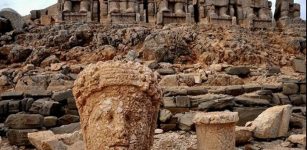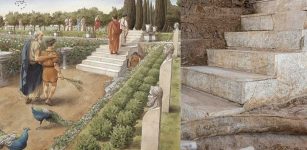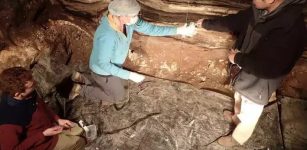Hogmanay: Scotland’s New Year Celebration Inherited From The Vikings
Ellen Lloyd - AncientPages.com - On December 31, Scotland celebrates Hogmanay. It’s a very old tradition, and the celebrations continue into the first couple days of January. Many local areas have their own customs for celebrating Hogmanay, which are all spectacular!
Traditional Hogmanay celebrations were originally brought to Scotland by the invading Vikings in the early 8th and 9th centuries.
New Year is still called Yules, deriving from the Scandinavian word for the midwinter festival of Yule. The long history of Viking and Norse settlement in Scotland is the reason why these two nations share many ancient traditions.
Where Did The Word Hogmanay Come From?
The origin of the word "Hogmanay" is unknown. Many theories have been put forward, and opinions differ as to whether the word originated from the Gaelic oge maidne ("New Morning"), Anglo-Saxon Haleg Monath ("Holy Month"), or Norman French word hoguinané, which was derived from the Old French anguillanneuf ("gift at New Year").
Hogmanay procession. Image credit: Visit Scotland
It has also been suggested that it came from the French au gui mener ("lead to the mistletoe") or a Flemish combo hoog ("high" or "great"), min ("love" or "affection") and dag ("day").
Hogmanay consists of several ancient traditions that are still practiced today.
"First Footing" – May It Be A Dark Male
First footing is a Hogmanay tradition still practiced across Scotland.
After the stroke of midnight, neighbors visit each other, bringing gifts such as shortbread or black bun, a kind of fruit cake. The visitor, in turn, is offered a small whiskey. The first foot should be a dark male to ensure good luck for the house.
Image credit: Scotsman Food and Drink
The dark male bit is believed to be a throwback to the Viking days, when a big blonde or redhead stranger arriving on your doorstep with a big axe meant big trouble and probably not a very happy New Year!
Cleaning The House And Taking Out The Ashes From The Fire
Before the Hohmanay can begin, families must clean the house and remove the ashes from the fireplace. The house must be ready for the New Year. There is also the superstition to clear all your debts before "the bells" at midnight. This is, without a doubt, easier said than done these days.
The Singing Of Auld Lang Syne
Immediately after midnight, it is traditional to sing Robert Burns' "For Auld Lang Syne".
Torch And Bonfire Ceremonies
The Hogmanay celebrations vary slightly in different areas of Scotland. In addition to national observance, many local areas have their own customs for celebrating Hogmanay.
In Edinburgh and throughout many cities in Scotland, you can see magnificent fireworks displays and torchlight processions.
The traditional New Year ceremony would involve people dressing up in cattle hides and running around the village being hit by sticks.
Hogmanay celebration in Edinburgh. Torchlight procession with fireworks in the background. Credit: Adobe Stock - Marcel
The festivities would also include the lighting of bonfires, rolling blazing tar barrels down the hill, and tossing torches. Animal hide was also wrapped around sticks and ignited, producing smoke believed to be very effective in warding off evil spirits. The smoking stick was also known as a Hogmanay.
Some of these customs do continue, especially in the small, older communities in the Highlands and Islands of Scotland, where tradition, along with language and dialect are kept alive and well.
On the Isle of Lewis, in the Outer Hebrides, the young boys form themselves into opposing bands, the leader of each wears a sheep skin, while a member carries a sack. The bands move through the village from house to house reciting a Gaelic rhyme.
On being invited inside, the leader walks clockwise around the fire, while everyone hits the skin with sticks. The boys would be given some bannocks - fruit buns - for their sack before moving on to the next house.
Stonehaven fireballs. Image credit: Visit Scotland
One of the most spectacular Fire ceremonies occurs in Stonehaven, just south of Aberdeen on the North East coast. The locals make giant balls of tar, paper, and chicken wire here. Weighing up to 20 pounds, these giant fireballs are lit and swung around on five feet long metal poles, requiring 60 men to carry them as they march up and down the High Street.
At the end of the festival, any balls still on fire are cast into the water. The origin of the pre-Christian custom is believed to be linked to the Winter Solstice of late December, with the fireballs signifying the sun's power to purify the world by consuming evil spirits.
The Reason Why Hogmanay Is Very Important In Scotland
For around 400 years, from the end of the 17th century to the 1950s, Scots were not allowed to celebrate Christmas. The reason for this has its roots in the Protestant Reformation when Kirk portrayed Christmas as a Popish or Catholic feast and therefore had to be banned.
Many Scots had to work over Christmas, and their winter solstice holiday was, therefore, at New Year when family and friends gathered for a party and exchange presents, especially for the children, which came to be called Hogmanay.
Symbolism Of Fire At Hogmanay
During Hogmanay celebrations, fire is considered a powerful and important symbol.
The flame and fire at Hogmanay symbolize many things. The bringing of the light of knowledge from one year to the next, lighting the way into the next uncharted century, putting behind you the darkness past, but carrying forward its sacred flame of hope and enlightenment to a better parish, and in this day, a new fresh year, burning away of the old to make space for the new.
If you enjoyed celebrating Hogmanay and you want to experience another great Scottish festival, then head to the Shetland Islands the incredible Up Helly Aa Festival is celebrated annually. During the Up Helly Aa festival in Lerwick, Shetland Islands, one can experience the sacrifice of a longship. The annual festival began in 1870.
It celebrates the influence of the Scandinavian Vikings in the Shetland Islands. The Norse ruled Shetland and the neighboring island Orkney for about 500 years until they became part of Scotland in 1468. Almost half of all people on Shetland today have Viking ancestry.
Updated on December 30, 2023
Written by Ellen Lloyd – AncientPages.com
Copyright © AncientPages.com All rights reserved. This material may not be published, broadcast, rewritten or redistributed in whole or part without the express written permission of AncientPages.com
Expand for referencesMore From Ancient Pages
-
 Strange Tale Of Mysterious Thousand-Year-Old Underground Network Of Caves And Encounters With Subterranean Dwellers
Featured Stories | Jul 13, 2022
Strange Tale Of Mysterious Thousand-Year-Old Underground Network Of Caves And Encounters With Subterranean Dwellers
Featured Stories | Jul 13, 2022 -
 Kommagene Civilization And The Ancient City Of Perge
Civilizations | Jan 25, 2016
Kommagene Civilization And The Ancient City Of Perge
Civilizations | Jan 25, 2016 -
 Mysterious Massive 3,800-Year-Old Structure And Passageway Found In The Jezreel Valley, Israel
Archaeology | Aug 23, 2023
Mysterious Massive 3,800-Year-Old Structure And Passageway Found In The Jezreel Valley, Israel
Archaeology | Aug 23, 2023 -
 2,700-Year-Old Face Cream For Men Found In Chinese Tomb
Archaeology | Feb 10, 2021
2,700-Year-Old Face Cream For Men Found In Chinese Tomb
Archaeology | Feb 10, 2021 -
 New West Papua Findings Provide Insights Into Early Human Migration To The Pacific
Featured Stories | Aug 13, 2024
New West Papua Findings Provide Insights Into Early Human Migration To The Pacific
Featured Stories | Aug 13, 2024 -
 Pregnant Woman’s Remains With An 8-Month Fetus Unearthed At Ancient Taosibei Cemetery, Shanxi, China
Archaeology | Jun 13, 2022
Pregnant Woman’s Remains With An 8-Month Fetus Unearthed At Ancient Taosibei Cemetery, Shanxi, China
Archaeology | Jun 13, 2022 -
 Comet Strike 13,000 Years Ago May Have Changed Human Civilization
Archaeology | Jul 6, 2021
Comet Strike 13,000 Years Ago May Have Changed Human Civilization
Archaeology | Jul 6, 2021 -
 Lavish Home And Exotic Garden Of Emperor Caligula Discovered In Rome
Archaeology | Nov 19, 2020
Lavish Home And Exotic Garden Of Emperor Caligula Discovered In Rome
Archaeology | Nov 19, 2020 -
 ChatGPT Is Confronting, But Humans Have Always Adapted To New Technology – Ask The Mesopotamians, Who Invented Writing
Featured Stories | Feb 13, 2023
ChatGPT Is Confronting, But Humans Have Always Adapted To New Technology – Ask The Mesopotamians, Who Invented Writing
Featured Stories | Feb 13, 2023 -
 Oshun Goddess Of Yoruba People Who Brings All Things That Make Life Worth Living
African Mythology | Mar 29, 2019
Oshun Goddess Of Yoruba People Who Brings All Things That Make Life Worth Living
African Mythology | Mar 29, 2019 -
 Legend Of The Sun And Moon In Cherokee Beliefs
Featured Stories | Jul 9, 2019
Legend Of The Sun And Moon In Cherokee Beliefs
Featured Stories | Jul 9, 2019 -
 Adorable Village Of The Little People In Connecticut
Featured Stories | Jul 25, 2019
Adorable Village Of The Little People In Connecticut
Featured Stories | Jul 25, 2019 -
 Mada’in Saleh: Spectacular Rock-Cut Tombs And Monuments Reflect Great Skills Of Nabataean Builders
Featured Stories | Aug 18, 2020
Mada’in Saleh: Spectacular Rock-Cut Tombs And Monuments Reflect Great Skills Of Nabataean Builders
Featured Stories | Aug 18, 2020 -
 DNA Reveals 300,000 Years Of Hominin And Animal Presence At Denisova Cave
Archaeology | Jun 26, 2021
DNA Reveals 300,000 Years Of Hominin And Animal Presence At Denisova Cave
Archaeology | Jun 26, 2021 -
 Excavation And Restoration Of New Rooms In The Pyramid Of Sahura In Abusir
Archaeology | Sep 27, 2023
Excavation And Restoration Of New Rooms In The Pyramid Of Sahura In Abusir
Archaeology | Sep 27, 2023 -
 Archaeologists Refute Claims That A Comet Destroyed Hopewell Culture
Archaeology | Aug 11, 2023
Archaeologists Refute Claims That A Comet Destroyed Hopewell Culture
Archaeology | Aug 11, 2023 -
 Mystery Of The Ancient Unknown Mining Civilization In North America – Connecting the Dots – Part 2
Civilizations | Apr 23, 2022
Mystery Of The Ancient Unknown Mining Civilization In North America – Connecting the Dots – Part 2
Civilizations | Apr 23, 2022 -
 Beautiful And Unique Ancient Roman Hoard Discovered In UK
Archaeology | Oct 3, 2017
Beautiful And Unique Ancient Roman Hoard Discovered In UK
Archaeology | Oct 3, 2017 -
 Secret History Of The Micmac – The Mysterious Red Earth People
Civilizations | Jun 22, 2020
Secret History Of The Micmac – The Mysterious Red Earth People
Civilizations | Jun 22, 2020 -
 2,000-Year-Old Factory Producing Roman Fish Sauce Unearthed In Ashkelon, Israel
Archaeology | Jan 7, 2020
2,000-Year-Old Factory Producing Roman Fish Sauce Unearthed In Ashkelon, Israel
Archaeology | Jan 7, 2020





